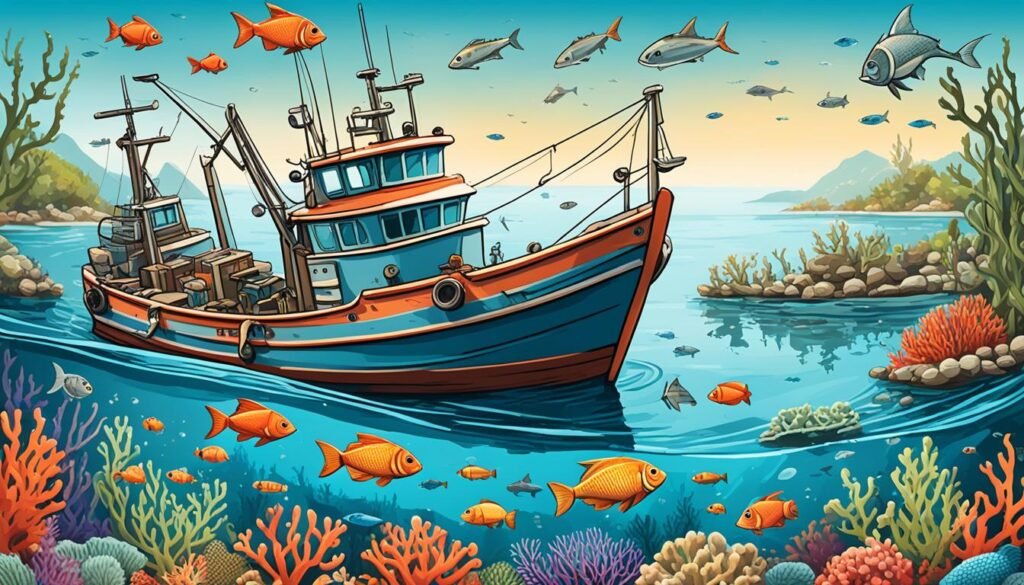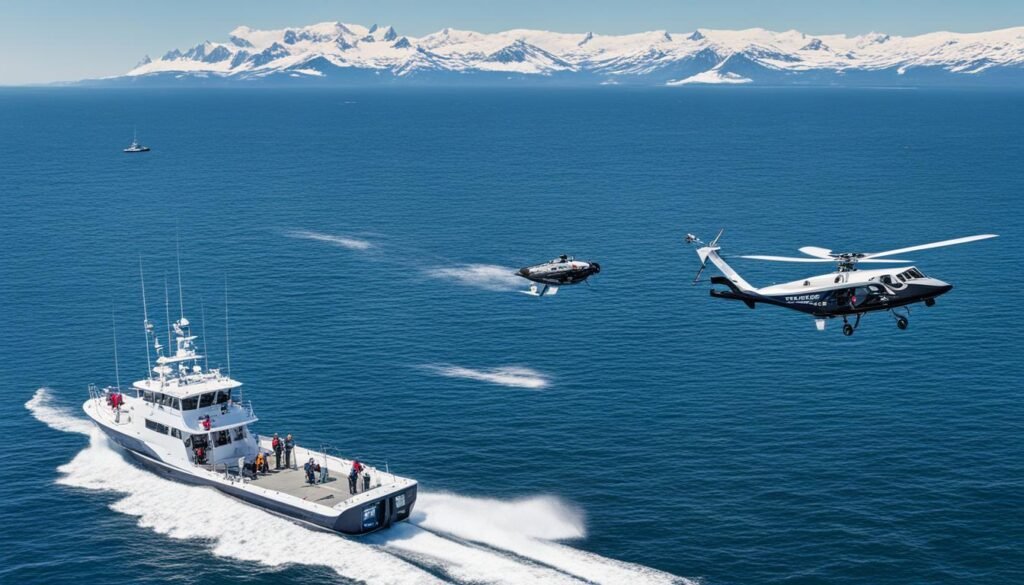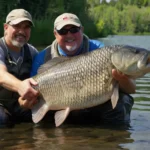Explore Canada's Ultimate Fishing, Hunting, and Wildlife Adventures
Top Canadian Fishing Conservation Organizations

Outdoor activities like fishing, hunting, trapping, and sport shooting significantly contribute to Canada’s economy. In 2018, they added a remarkable $13.2 billion to the nation’s gross domestic product, representing 0.6% of the entire economy.
This surprising statistic underscores the considerable economic impact of these pursuits. It also highlights the importance of preserving aquatic ecosystems for future generations through the efforts of fishing conservation organizations nationwide.
Key Takeaways about Canadian Fishing Conservation Organizations
- In 2018, fishing, hunting, trapping, and sport shooting contributed $13.2 billion to Canada’s GDP.
- These activities supported nearly 107,000 jobs with labor income of $6.4 billion.
- Canada has 2.97 million licensed anglers, 1.27 million hunters, 45,000 trappers, and 1.4 million sport shooters.
- The economic benefit boosted government revenue by $6.1 billion in 2018.
- Leading conservation organizations promote sustainable angling and habitat preservation.
Significance of Fishing in Canada
Fishing plays a vital role in Canada’s economy. It generates substantial revenue and creates numerous jobs. The economic impact of fishing in Canada is remarkable.
The industry contributes billions to Canada’s gross domestic product annually.
Economic Contribution
The fishing industry significantly drives Canada’s economy. Statistics show fishing, hunting, trapping, and sport shooting contributed $13.2 billion to Canada’s GDP in 2018.
This accounts for 0.6% of the national economy.
Employment Generation
The fishing sector is a major employment source. It supports thousands of Canadians’ livelihoods. These activities collectively sustained nearly 107,000 Canadian jobs in 2018.
The estimated labor income was $6.4 billion.
Government Revenue
The fishing revenue generated for the government is substantial. Economic benefits from fishing and related pursuits boosted federal and provincial revenue by $6.1 billion in 2018.
| Contribution | Amount |
|---|---|
| GDP Contribution | $13.2 billion |
| Employment Supported | 107,000 jobs |
| Labor Income | $6.4 billion |
| Government Revenue | $6.1 billion |
These figures highlight the fishing industry’s immense significance in Canada. It contributes substantially to economic prosperity while providing employment opportunities and generating government revenue.
Disclosure: When you purchase a service or a product through our links, we sometimes earn a commission, at no extra cost to you.
Fishing Conservation Organizations
Canada boasts prominent organizations dedicated to preserving aquatic ecosystems and promoting sustainable fishing practices. Notable entities are the Canadian Parks and Wilderness Society (cpaws), Nature Conservancy of Canada, and Trout Unlimited Canada.
Canadian Parks and Wilderness Society (CPAWS)
As Canada’s only charity focused solely on protecting public land, freshwater, and oceans, CPAWS plays a pivotal role in fishing conservation. By safeguarding habitats and combating biodiversity loss and climate change, CPAWS has conserved over half a million square kilometers of land and water.
Fly to Your Canadian Fishing Paradise
Book cheap flights to Canada's best fishing spots!
One search, all flights
Find the best deals to your favorite fishing spots
Kiwi.com Guarantee
Travel worry-free with our protection
Trusted by millions
Join anglers booking cheap flights with ease
Disclosure: When you purchase a service or a product through our links, we sometimes earn a commission, at no extra cost to you.
Nature Conservancy of Canada
The Nature Conservancy of Canada conserves natural areas and biological diversity. Through land acquisition and stewardship initiatives, they preserve vital aquatic habitats sustaining thriving fish populations and supporting fishing conservation efforts.
Trout Unlimited Canada
Trout Unlimited Canada focuses on freshwater ecosystems and trout fisheries. Dedicated to conserving, protecting, and restoring these resources, their efforts encompass habitat restoration to advocacy, ensuring long-term sustainability of Canada’s cherished fishing conservation heritage.
| Organization | Mission | Key Contributions |
|---|---|---|
| Canadian Parks and Wilderness Society (CPAWS) | Protecting public land, freshwater, and oceans | Conserved over 500,000 sq km of land and water |
| Nature Conservancy of Canada | Conserving natural areas and biodiversity | Land acquisition and stewardship initiatives |
| Trout Unlimited Canada | Conserving freshwater ecosystems and trout fisheries | Habitat restoration, advocacy, and sustainability |
Role of Conservation Organizations

Canadian fishing conservation groups safeguard aquatic habitats and endangered species. They advocate for sustainable fishing methods. Their efforts preserve biodiversity and natural resources.
Habitat Protection
These organizations focus on habitat conservation in Canada. They preserve wetlands, rivers, lakes, and coastal areas. These areas are critical habitats for fish species. Through land acquisition, restoration, and advocacy, they maintain ecosystem integrity.
Preserving these delicate ecosystems ensures aquatic life survives and thrives.
Species Conservation
Conservation groups play a vital role in protecting endangered species. They implement breeding programs, restocking initiatives, and campaign for protective policies. Their efforts prevent extinction of threatened fish populations. They foster recovery, safeguarding essential biodiversity for healthy ecosystems.
Sustainable Fishing Practices
These organizations promote sustainable fishing methods among anglers. Educational programs instill ethical practices like catch-and-release, proper fish handling, and responsible angling. Minimizing impact on fish stocks maintains healthy populations. It ensures recreational fishing’s longevity for future generations.
Conserving fish and wildlife habitats offers human health, recreation, aesthetic, and economic benefits.
By fostering environmental stewardship and sustainable practices, Canadian fishing conservation organizations preserve natural heritage. They ensure long-term viability of aquatic ecosystems.
Canada’s Model for Sustainable Fisheries Management

Canada has implemented a comprehensive model for sustainable fisheries management. This approach includes meticulous planning, science-based decision-making, and proactive environmental impact management. The goal is to balance responsible resource use and long-term conservation.
Planning
A key part of Canada’s strategy is developing thorough management plans. These plans outline catch limits, quotas, fishing seasons, gear restrictions, and conservation goals. The planning process relies on robust data to ensure sustainable exploitation levels.
These comprehensive blueprints are tailored to individual fish stocks. They aim to conserve and rebuild vulnerable fish populations.
Science-Based Decisions
Canada’s fisheries policies and regulations are informed by science-based decision-making. Fisheries and Oceans Canada collaborates with research institutions, universities, and international organizations. This ensures management strategies are grounded in rigorous scientific principles.
The evidence-based approach accounts for factors like population dynamics, ecosystem interactions, and climate change impacts.
Managing Environmental Impacts
Canada’s framework emphasizes managing environmental impacts from fishing activities. Stringent assessments evaluate potential effects on critical habitats, bycatch, and sensitive ecosystems.
This proactive approach enables targeted mitigation measures like area closures, gear modifications, and bycatch reduction strategies. The aim is to minimize fishing’s ecological footprint.
| Fishery | Landed Value (2014) |
|---|---|
| Geoduck Clam (British Columbia) | $40.5 million |
| Bluefin Tuna | $6 million |
| Chinook Salmon | $13.9 million |
| Capelin | $1.8 million |
| Lobster Fishing Area 34 | $310 million |
| Greenland Halibut | $102 million |
Through this holistic, science-driven approach, Canada remains at the forefront. It safeguards marine resources’ long-term viability while nurturing a thriving fishing industry.
Enforcement and Monitoring

Canada has an advanced system to enforce fishing rules. The government spends $130 million yearly for this purpose.
The system ensures sustainable harvesting practices. It helps maintain compliance with regulations.
Legislation and Regulations
Canada’s fisheries follow comprehensive laws and regulations. These establish rules for the industry.
The rules include licensing requirements for fish harvesters. They also specify gear restrictions and catch limits.
Other provisions govern fishing activities.
Onboard Observers
Independent observers are placed on commercial fishing vessels. Their role is to verify catch data.
The observers monitor compliance with regulations. They also collect biological samples for scientific assessments.
Aerial and At-Sea Patrols
Canada uses aerial surveillance and at-sea patrols. Over 630 fishery officers conduct these patrols.
The patrols monitor vessel activity within Canada’s waters. They detect any infractions or illegal fishing.
Canada’s waters extend to a 200-mile exclusive economic zone.
Other measures include dockside monitoring programs. Electronic monitoring systems on vessels and gear are used.
Logbooks and hail-in/hail-out protocols track fishing effort accurately. They also track catches precisely.
Major Fishing Exports and Sustainability

Canada’s dedication to sustainable fisheries management has made fish and seafood exports one of the nation’s largest export commodities. In 2018, the country exported $6.9 billion worth of fish and seafood to 139 countries worldwide.
Top 10 Global Exports
Among Canada’s top fish exports, lobster was the most valuable at $2.2 billion. Atlantic salmon followed at $971 million, and snow crab secured third with $886 million.
Other notable exports included shrimp ($469 million), crab ($420 million), salmon ($220 million), scallop ($163 million), herring ($136 million), clam ($120 million), and hake ($116 million).
Other Sustainable Exports
Besides high-value fisheries products, Canada also exports sustainable seafood like haddock, sablefish, Arctic char, Pacific halibut, and Atlantic swordfish. These species are managed to ensure long-term population and ecosystem viability.
Sustainable practices extend beyond exports. Domestic consumption of sustainable Canadian seafood also maintains a thriving and responsible fishing industry within Canada.
Fishing Conservation Organizations
Among Canada’s prominent sustainable fishing groups, WWF Canada stands out. It rebuilds depleted fish populations and protects marine habitats. WWF advocates ending overfishing, bycatch, and destructive fishing methods.
Ocean Wise
Ocean Wise, WWF-Canada’s initiative, promotes sustainable seafood choices. The program educates about ocean-friendly seafood options. It partners with restaurants, retailers, and suppliers to offer recommended products.
Collaborative Approach
WWF-Canada collaborates with diverse stakeholders for fishing conservation. It works with government, First Nations, fishing sectors, researchers, and communities. This approach ensures understanding challenges and developing effective solutions.
| Initiative | Description |
|---|---|
| Habitat Restoration | Restoring critical aquatic habitats through community-driven projects |
| Research and Monitoring | Conducting scientific research and monitoring programs to assess fish populations and ecosystem health |
| Public Awareness | Educating the public about sustainable fishing practices, responsible seafood choices, and the importance of conservation |
Fostering partnerships, promoting sustainable seafood, and implementing science-based strategies, WWF-Canada works towards thriving aquatic ecosystems. Its goal is safeguarding fish populations for future generations.
Challenges and Threats
Despite comprehensive efforts in sustainable fisheries management, several critical challenges endanger fishing industry viability and aquatic ecosystems.
These include invasive species threatening native fish populations, habitat loss from human activities, and climate change impacts.
Aquatic Invasive Species
Canadian fisheries face the spread of invasive species wreaking havoc on ecosystems and fish stocks. Over 164 aquatic species are listed as invasive.
Examples include zebra mussels, invasive tunicates, sea lamprey, and Asian carp, outcompeting and displacing indigenous species, disrupting food webs, and causing substantial damage.
Habitat Degradation
Aquatic habitat quality is essential for fish survival and prosperity. Habitat degradation from pollution, industrial activities, urban development impairs these critical environments.
Contaminants, sedimentation, wetland alteration severely impact fish ability to thrive and reproduce, potentially leading to population declines.
Climate Change
Climate change consequences pose a significant threat to fishing industry and marine ecosystems. Canada warms twice the global average rate.
Warmer, more acidic, less oxygenated oceans disrupt fish migration, prey distribution, making areas uninhabitable for certain fish populations.
Ocean acidification reduces carbonate ions crucial for shell-building organisms. Extreme weather degrades water quality through increased runoff and coastal erosion.
Community Involvement and Support
The success of fishing conservation in Canada relies on community involvement. There are many ways individuals can contribute to protecting fisheries for future generations.
Many organizations welcome volunteers to assist with monitoring waterways, participating in cleanups, restoring habitats, and promoting sustainable angling through educational programs.
Volunteer Opportunities
For instance, the Stream to Sea Education Program engages nearly 20,000 students per year in British Columbia and the Yukon, fostering appreciation for aquatic ecosystems.
Donations and Funding
Financial contributions through donations and funding enable conservation groups to carry out critical research, advocacy, and on-ground work. The Community Involvement Contribution Program funds activities like stewardship, stock assessment, salmon enhancement, and community-based habitat restoration.
Organizations like Trout Unlimited Canada, improving Canadians’ lives for over 50 years, exemplify donations’ impact. For every $1 donated, they put $4 worth of work on the ground.
Sustainable Fishing Practices
Anglers contribute to sustainability by embracing ethical catch-and-release, properly handling fish, avoiding sensitive spawning areas, and minimizing environmental impact. Adopting responsible sustainable angling techniques conserves Canada’s freshwater ecosystems and coldwater resources.
Government Initiatives and Policies
The Canadian government acknowledges sustainable fisheries’ importance. It has implemented various canadian fisheries legislation and initiatives to conserve these vital resources.
The Fisheries Act serves as the primary canadian fisheries legislation. It provides a regulatory framework for managing fish habitats and enforcing sustainable harvesting practices.
Fisheries Act
The Fisheries Act aims to protect and conserve fish and habitats, ensuring sustainable fisheries resources management. It prohibits harmful alterations, disruptions, or destruction of habitats.
The Act regulates activities that could adversely impact ecosystems. It sets rules for commercial and recreational fishing, including licensing, gear, and catch limits.
Species at Risk Act
The Species at Risk Act (SARA) is crucial endangered fish species laws designed to protect endangered or threatened aquatic species and critical habitats.
Under SARA, recovery strategies and action plans identify threats, promote conservation, and facilitate at-risk fish populations’ recovery.
National Hunting, Trapping, and Fishing Heritage Day
Canada celebrates the national fishing heritage day canada annually on the third Saturday of September. This initiative highlights hunting, trapping, and fishing’s cultural and economic significance.
It promotes conservation principles and sustainable practices related to these pursuits.
Besides core policies, the government has implemented strategies and programs addressing challenges and supporting conservation efforts.
- The Atlantic Fisheries Fund invests over $400 million to support sustainable Atlantic Canada fisheries.
- The Cod stock recovery program facilitates northern cod population recovery.
- The Ghost Gear Fund encourages actions to reduce marine plastic pollution.
- The Beneficial Ownership Survey aims to understand commercial fisheries access beneficiaries.
- Funding programs for Indigenous groups establish aquatic resource management bodies.
- Initiatives like the Ecosystems approach to fisheries management consider ecosystem variables in decision-making.
These government initiatives, policies, public consultations, and stakeholder engagement demonstrate Canada’s commitment to preserving fishing heritage while ensuring aquatic resources’ long-term sustainability.
Conclusion
As we gaze towards the future of sustainable fishing, conservation organizations’ tireless efforts preserve aquatic ecosystems and fish populations.
Canada’s fisheries policies and enforcement mechanisms are strong, but groups’ habitat restoration, research, advocacy, and education remain vital.
Supporting these organizations through volunteering, donations, and responsible angling practices allows all Canadians to ensure sustainability.
Collective action preserves fisheries’ benefits, from recreation to boosting local economies.
As stewards, embracing sustainable practices and supporting conservation groups safeguards angling traditions and habitats.
Working together responsibly secures this legacy, ensuring fishing’s joy endures.
FAQ about Canadian Fishing Conservation Organizations
What is the economic contribution of fishing, hunting, trapping and sport shooting activities in Canada?
Fishing, hunting, trapping and sport shooting contributed .2 billion to Canada’s GDP in 2018. These activities supported nearly 107,000 jobs with .4 billion labor income. They boosted government revenue by .1 billion in 2018.
What are some prominent fishing conservation organizations in Canada?
Prominent fishing conservation organizations in Canada include CPAWS, Nature Conservancy of Canada, Trout Unlimited Canada, and WWF-Canada. They focus on conserving aquatic habitats, protecting fish species, and promoting sustainable fishing.
How does Canada manage its fisheries sustainably?
Canada has a comprehensive model for sustainable fisheries management. It includes planning, science-based decision-making, and managing environmental impacts. Management plans outline total allowable catch, allocations, seasons, gear restrictions and goals.
What are some major Canadian fishing exports and their sustainability?
Canada’s top fishing exports in 2018 included lobster, Atlantic salmon, snow crab, shrimp, and crab. Other major sustainable exports are haddock, sablefish, Arctic char, Pacific halibut, and Atlantic swordfish.
What are some challenges and threats faced by fishing conservation efforts in Canada?
Key challenges include aquatic invasive species, habitat degradation from pollution and development, and climate change impacts. These impacts include warming waters, ocean acidification, and changes in prey availability.
How can communities support fishing conservation in Canada?
Communities can support through volunteer opportunities, donations, and funding support for organizations. Embracing sustainable practices like ethical catch-and-release, proper fish handling, and minimizing impacts on sensitive areas also helps.
What government initiatives and policies support fishing conservation in Canada?
The Fisheries Act provides a regulatory framework for managing fish habitats and enforcing sustainable practices. The Species at Risk Act aims to protect endangered aquatic species and habitats. National Hunting, Trapping, and Fishing Heritage Day highlights these activities’ importance while promoting conservation.
Source Links
- https://www.ofah.org/nfhc/
- https://tucanada.org/
- https://www.dfo-mpo.gc.ca/fisheries-peches/sustainable-durable/fisheries-peches/index-eng.html
- https://en.wikipedia.org/wiki/Fisheries_and_Oceans_Canada
- https://www.canada.ca/en/services/environment/conservation/assessments/environmental-reviews/fish-habitat-protection.html
- https://greatriverfishing.com/great-river-fishing-adventures/sturgeon-salmon-conservation/
- https://www.ofah.org/about-us/who-we-are/
- https://www.aftco.com/pages/conservation









